Volcanologist
Minerals and volcanoes
 My name is Julie Roberge, I am from Quebec, but presently I am finishing my PhD in volcanology at University of Oregon, USA.
One spring day in 1980, my
father made a big deal about washing the car. Why? He
said, “A volcano is erupting in the United States,
and tomorrow morning I will show you the volcano’s
ashes. This is why the car has to be sparkling
clean.” We were in Quebec, Canada, and the volcano
(Mount St. Helens) was erupting on the west coast, so I
was amazed the next morning when I saw the thin layer of
ash on my father’s car. I was 8 years old at the
time, and I became so intrigued and curious about
volcanoes that it turned into a passion. My parents never
stopped feeding my interest with books and magazines
about volcanoes. So, I became a geologist and then
specialized in volcanology.
My name is Julie Roberge, I am from Quebec, but presently I am finishing my PhD in volcanology at University of Oregon, USA.
One spring day in 1980, my
father made a big deal about washing the car. Why? He
said, “A volcano is erupting in the United States,
and tomorrow morning I will show you the volcano’s
ashes. This is why the car has to be sparkling
clean.” We were in Quebec, Canada, and the volcano
(Mount St. Helens) was erupting on the west coast, so I
was amazed the next morning when I saw the thin layer of
ash on my father’s car. I was 8 years old at the
time, and I became so intrigued and curious about
volcanoes that it turned into a passion. My parents never
stopped feeding my interest with books and magazines
about volcanoes. So, I became a geologist and then
specialized in volcanology.
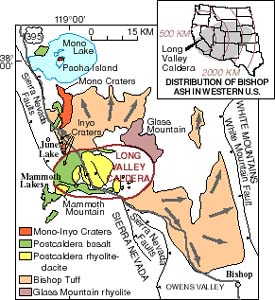 I work on the Long Valley caldera
volcano in California, which is a rhyolite caldera
complex formed by a catastrophic eruption about 730,000
years ago, producing 600 cubic km of rhyolitic magma to
the surface. A caldera is a large volcanic depression
that is more or less circular in form. You may think
that this doesn’t sound like a volcano, but it
turns out that caldera are produced by the most explosive
of Earth's volcanoes. In fact they are usually so
explosive when they erupt, they end up collapsing in on
themselves rather than building a tall structure. These
caldera-forming events indicate that the magma chambers
associated with the eruptions are huge.
I work on the Long Valley caldera
volcano in California, which is a rhyolite caldera
complex formed by a catastrophic eruption about 730,000
years ago, producing 600 cubic km of rhyolitic magma to
the surface. A caldera is a large volcanic depression
that is more or less circular in form. You may think
that this doesn’t sound like a volcano, but it
turns out that caldera are produced by the most explosive
of Earth's volcanoes. In fact they are usually so
explosive when they erupt, they end up collapsing in on
themselves rather than building a tall structure. These
caldera-forming events indicate that the magma chambers
associated with the eruptions are huge.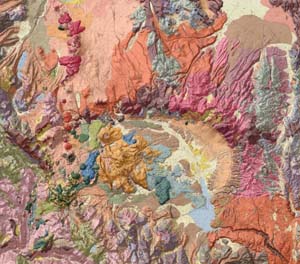 In fact, layers
of ash often extend over thousands of square kilometers
in all directions from these calderas. Fortunately we
haven't had to live through one of these mega eruptions
although the eruption of Mt Pinatubo in 1991 did produce
a small caldera. Beside ash falls and ash flows these
eruptions are also accompanied by high-speed flows of
turbulent mixture of hot gases and unsorted pyroclastic
material (volcanic fragments, crystals, ash, pumice, and
glass shards) called pyroclastic flows.
In fact, layers
of ash often extend over thousands of square kilometers
in all directions from these calderas. Fortunately we
haven't had to live through one of these mega eruptions
although the eruption of Mt Pinatubo in 1991 did produce
a small caldera. Beside ash falls and ash flows these
eruptions are also accompanied by high-speed flows of
turbulent mixture of hot gases and unsorted pyroclastic
material (volcanic fragments, crystals, ash, pumice, and
glass shards) called pyroclastic flows.
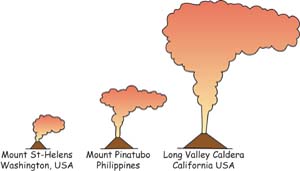
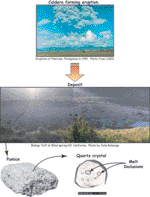 For my thesis, I collected pumice samples from the Bishop
Tuff eruption in the Long Valley caldera. Pumice is a
light-colored, frothy volcanic rock, formed by the
expansion of gas in erupting lava. It can be found as
pieces or larger fragments, but it also can occur
abundantly as ash-sized particles. If you think you have
a peace of pumice at home put it in water: if it floats
you possibly have a nice pumice sample! After collecting
my pumice samples I crushed them and hand picked quartz
and sanidine crystals.
For my thesis, I collected pumice samples from the Bishop
Tuff eruption in the Long Valley caldera. Pumice is a
light-colored, frothy volcanic rock, formed by the
expansion of gas in erupting lava. It can be found as
pieces or larger fragments, but it also can occur
abundantly as ash-sized particles. If you think you have
a peace of pumice at home put it in water: if it floats
you possibly have a nice pumice sample! After collecting
my pumice samples I crushed them and hand picked quartz
and sanidine crystals.
Now, what do minerals have to do with volcanoes?
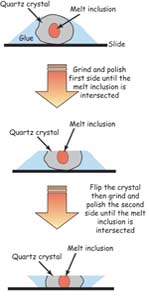 Quartz and sanidine crystals
in pumice often contain melt inclusions, which are small
(~0.001-0.3 mm) blebs of silicate melt trapped within the
crystal. Melt inclusions can be used to assess different
properties of the melt before it erupts. Because they can
form at high pressures and are contained within
relatively incompressible crystal hosts, they may retain
high concentrations of volatile (gas like H2O
and CO2) that normally escape from magmas
during degassing. As such, analysis of these inclusions
provides direct information on the volatile contents of
magmatic systems before the eruption.
Quartz and sanidine crystals
in pumice often contain melt inclusions, which are small
(~0.001-0.3 mm) blebs of silicate melt trapped within the
crystal. Melt inclusions can be used to assess different
properties of the melt before it erupts. Because they can
form at high pressures and are contained within
relatively incompressible crystal hosts, they may retain
high concentrations of volatile (gas like H2O
and CO2) that normally escape from magmas
during degassing. As such, analysis of these inclusions
provides direct information on the volatile contents of
magmatic systems before the eruption.
I use Fourier transform infrared (FTIR) spectroscopy to
measure the H2O and CO2 contents of
the melt inclusions. To prepare the samples for FTIR,
the quartz crystals containing the melt inclusions must
be doubly ground and polished into wafers with two
parallel sides. The melt inclusions to be analyzed must
be intersected on both sides of the wafer.
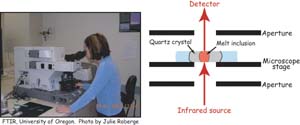
Finally, since the gas content in the magma controls the
explosivity of an eruption, crystals are useful to
understanding the formation, evolution and configuration
of large crustal magma chambers.
Build your own volcano!
Follow the link to learn how to build you own
volcano out of paper and cardboard and than simulate and
eruption using vinegar and baking soda.
Have fun!